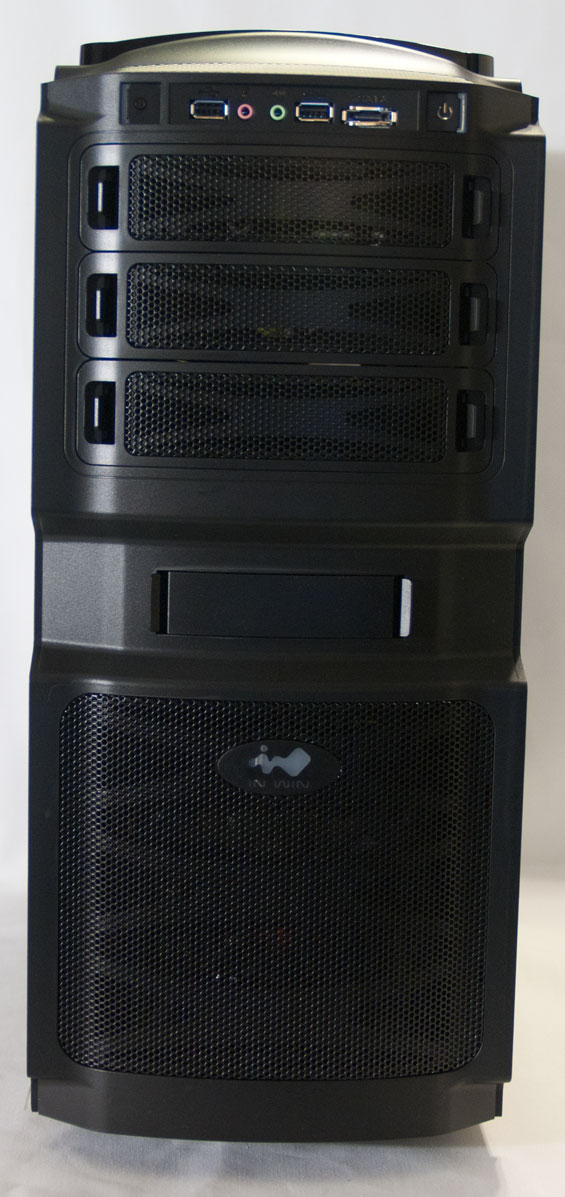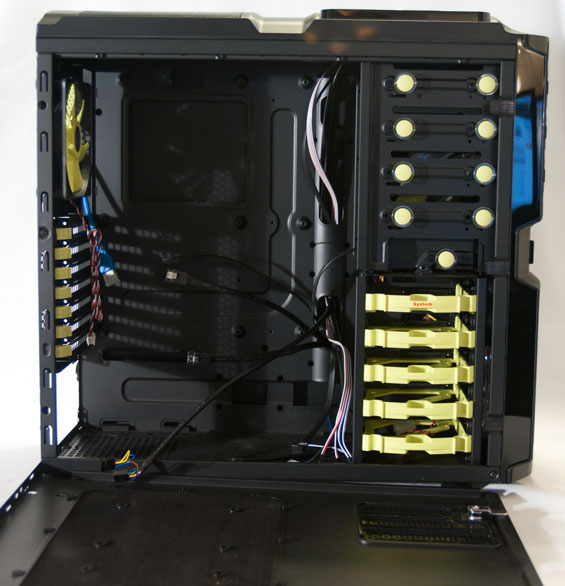IN-WIN BUC: Just How Much $100 Can Buy
by Dustin Sklavos on May 9, 2011 4:28 PM EST- Posted in
- Cases/Cooling/PSUs
- In-Win
- mid-tower
In and Around the IN-WIN BUC
I'll come out and say it: while I don't think it's anywhere near as ostentatious as a lot of gaming-oriented cases can be, the IN-WIN BUC could probably stand a little more understatement. There's no glossy plastic to be found anywhere on this chassis except for a light trim at the top and small side accents, though, and thankfully the lighting is in no way overpowering: the front logo glows red (this can be disabled), and the front fan glows blue. The color scheme is two-toned, with most of the case in black and assembly grommets and trays in a kind of neon yellow-green.
Build materials are the standard plastic and SECC steel one would expect in the price range, but the case feels sturdy and not liable to snap or break anywhere in particular. As we get into this, you'll see places where IN-WIN cut corners to keep costs down and generally speaking they're fairly smart with their approach.

The first thing that struck me when I started playing with the BUC was that it's a largely toolless case design. This is something I think some manufacturers even at the upper end of the field forget we actually appreciate, and what you're going to find is that there's an awful lot of thought given to practicality, ease of use, and flexibility when it comes to this case. The front covers for the 5.25" bays all snap in and out relatively easily, but they're secure enough so they don't rattle and have a squeeze-clamp kind of design that I actually prefer to the drive bay covers I've seen on more expensive cases like Antec's P182/P183 and Corsair's 600T. Practicality is king here.
When you go to open the case up, you'll find that instead of even thumbscrews, IN-WIN has adopted plastic clamps that work surprisingly well. If these aren't to your taste, you can remove them and just use conventional screws/thumbscrews to secure the panels. What I was really pleased with, and a couple of you are going to nod knowingly, is the fact that the side panels slide on and off with a minimum of fuss. I've used a few inexpensive cases where side panels didn't line up quite right or required a lot of force to budge once they were stuck in place.
The main side panel also features ventilation and mounts for two 120mm fans; clearance in the bottom mount is fine for video cards, but there wasn't enough room to put a fan in the top mount with our Zalman CNPS9900 CPU cooler attached. There's a smaller removable piece in the bottom right of the panel that uses a conventional case key; this gives you access to three of the hotswap bays. NewEgg cites the enclosure as having four bays, but that's not entirely true; only the first three can be accessed with the door and the fourth is only accessible if the entire side panel is removed.

Popping open the BUC reveals a largely toolless interior. 5.25" drives are secured by popping out the neon green knobs, sliding the drive in, and then popping the knobs back in--and you only have to do this on the main side of the enclosure. There's a single knob for the external 3.5" bay, and then there are five 3.5" drive trays, four of which connect seamlessly to a SATA backplane.
The motherboard tray has the standoffs for a full ATX board more or less built in, and amen to that. It's been a long time since I've seen a motherboard that uses any kind of nonstandard standoffs, so not having to install those is welcome. Above the motherboard area is an opening where an additional 120mm fan can be installed; two plastic clamps flex open as you insert the fan, and then it more or less locks into place. This felt a little bit loose to me and is definitely vibration prone.
Finally, the expansion bays include one actual removable slot cover, with the rest essentially needing to be bent and snapped off. That's disappointing, but on the bright side each of these have a clamp that rotates outside of the case: no screwing in expansion cards, and our GTX 580 was remarkably secure using these clamps.
















57 Comments
View All Comments
cjs150 - Tuesday, May 10, 2011 - link
Please include case dimensions in metric as well as inches. Motherboards, fans, radiators are all in metric measurements and it makes it a lot easier for those, like me, who stuff cases with lots of kit to work out will fit.I am also as frustrated as reviewer with cable routing. It really is not that difficult to allow a bit more space behind the motherboard tray. It is worse for me because I like silence from my pc and therefore want to put noise reducing stuff on the side panels.
Finally, I am not particularly bothered by the number of HD the case can hold (I am building a 6TB file server which will be enough for decades of films), all I need is space for 2 drives, an SSD + one HD. However, I do like to have an optical drive in the system. I have yet to see any case deal with providing real noise reduction/anti-vibration for an optical drive.
bhima - Tuesday, May 10, 2011 - link
The Antec 900 has become sort of the mainstream case standard. I think getting the data for that case will make it easier to judge what these numbers mean in the real world when testing other cases against it. That way, people can pick a case based on whether it cools better than the 900, or is quieter than the 900.Of course, once you have a bunch of cases reviewed, you won't need a reference case anymore, but while you build up a review archive it would be nice to get the info for such a popular case.
e_sandrs - Tuesday, May 10, 2011 - link
We've been using INWIN cases for a long time to build a few hundred computers per year and I have only good things to say about them! Very nice build quality for the price - I'm glad they're getting some love here on AT!xrror - Tuesday, May 10, 2011 - link
I kinda miss the stop motion video of you fighting with a screwdriver and actually installing a build into a case in this review. I wholeheartedly recommend buying a cheap electric screwdriver and having every case review feature you doing assemblies with the time lapse footage.I mean, reading about how all the pieces and such fit together is good - but seeing one wrangle with the cables and such really brings out a more practical view of a case. For instance in this review one thing that might stand out is the decided lack of need for a screwdriver. Also it would help show off the "backplane wiring" as you hooked up all the power connectors and then slide (I guess somehow?) the motherboard into the case.
jerem43 - Tuesday, May 10, 2011 - link
I've been using in-win cases for years. A strong sturdy case with ease of access, no sharp edges, quality power supplies and good heavy gauge steel make for an excellent case. Even their ,ore consumer oriented cases are a joy to work with, simple to access and maintain.kenyee - Friday, May 13, 2011 - link
That'd be a more useful noise test...use a standard drive and test how well you can hear the drive working...Michael Meio - Sunday, June 26, 2011 - link
It would be nice if as regular rule of computer case testing / reviewing, some part was dedicated to dust filters and the way they compare to other brands and models.IMO there are two kind of filters that cover the majority of options out there: Sponge and plastic.
I find that the presence of sponge or foam dust filters in a computer case shows some sort of lack of respect and a desperate corner cut attitude on the case manufacturer's part. A foam filter is in all aspects, the cheapest way to deal with it. It needs no special gap, no channel or punch holes to seat on, and obviously, minimum head scratching for the case's designer.
A plastic / nylon dust filter is different. It requires thinking. It needs a specific place to be. Just as the front cover or the side panels.. it relies on a designed mechanical solution to be attached to the case and held in place. It simply shows the attention to detail on the manufacturer's part.
The dust filters location, functionality, ease of use / remove / "washability" truly plays a big deal on my buying decision when it comes to chassis.
I don't own a BUC case and currently, I'm shopping around. It surprises me how difficult it is to find out what are computer case filters made of in pretty much every single review out there. Needless to mention, their location, ease of use, etc. This review unfortunately, is not an exception to that.